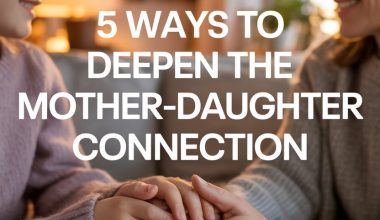When families blend, hearts and heads collide. The Brady Bunch made it look like a singalong with matching outfits.
Real life? More like a potluck where someone always forgets the forks. Blended families are beautiful, but no one’s pretending it’s easy.
If you’re staring at the calendar and wondering if this is the week your stepchild finally speaks to you (without eye-rolling), you’re not alone. Let’s get through the sticky bits together.
New Traditions, Please
Old family rituals are like a favourite old jumper—comfy, familiar, and, if you’re not careful, a tad exclusive. Kids can sniff out any hint that the “old gang” is leaving them out.
The trick? Create something new, silly, and distinctly yours as a blended crew.
It doesn’t have to be a festival. Maybe it’s Friday pancake dinners with toppings that would horrify your childhood self.
Perhaps it’s a weird family handshake no one else understands. The point is to build a fresh story together, not rewrite the old chapters.
If you’re after some science to back this up, a study published in Communication Studies Journal found that inventing new rituals helps blended families bond quicker and stave off resentment. Brownie points for science-backed pancakes.
Space: The Final Frontier
Blending doesn’t mean merging every toothbrush and T-shirt. Kids (and adults, let’s be honest) need their own little corners—literal and figurative.
Even if you don’t have spare rooms to assign, try for a shelf, a drawer, a “do not touch” box, or a bathroom caddy that’s off-limits to siblings.
Ownership equals security. Same goes for emotional space.
If a child wants to keep a few memories from their old setup private, respect it. You’re not erasing their past; you’re making room for their present.
This is especially vital for teenagers, who, according to child psychologist Dr. Lisa Damour, crave autonomy like toddlers crave snacks. No need to take it personally.
Communication Without Interrogation
Asking, “How was your day?” can feel more like an FBI interview than a heart-to-heart when you’re step-parenting. Instead, try open-ended, low-pressure conversations that don’t demand instant sharing.
Play Uno, wash dishes together, walk the dog—chat about nonsense and let the important stuff sneak out sideways. Sometimes, just being there counts way more than what’s actually said.
Family therapists like Dr. Patricia Papernow swear by casual, indirect chats over forced sit-downs. Give it a go—awkward silences make great compost for future conversations.
Don’t Skip the Couple Time
When you’re madly juggling schedules, lost soccer boots, and meal requests that sound like a cruise ship menu, the grown-up relationship can end up right at the bottom of the laundry basket.
Blending is a team sport, and the two of you are co-captains. A united front (with frequent huddles) is essential.
Even if it’s a ten-minute debrief after the kids are in bed, or a shared takeaway once a week, make couple time sacred.
Marriage therapists at The Gottman Institute found that investing in your partnership translates directly into stability for the kids. Kids notice. They really do.
Beware the Comparison Trap
It’s easy to fall into “Well, at my house, we always…” or “My ex never did it that way.”
Spoiler: No one wins here. Try not to treat family blending like a competitive sport, with points for “best lasagne” or “most elaborate Christmas.”
Instead, focus on what works for this family, right now.
What’s the minimum viable tradition everyone can agree on? Some weeks, it might just be surviving Sunday without a meltdown. Celebrate small wins.
A classic study published in Encyclopedia of Family Studies reminds us that blended families are different, not lesser. Cut yourself some slack.
Pick Your Battles
Your new stepson wears odd socks. Your biological child insists on ketchup with rice. Is this really the hill to die on? Not every battle needs to be fought, or even commented on.
Kids are testing boundaries not because they’re evil geniuses, but because they’re figuring out where the new lines are. Save your stern voice for safety stuff, kindness, and the truly non-negotiable.
According to Clinical Psychologist Dr. Laura Markham, flexibility reduces family stress and increases buy-in from reluctant kids. Translation: If it isn’t hurting anyone, let it go.
Build the Step-Relationship Slowly
No one bonds over forced fun. Think of this like making sourdough—slow, organic, sometimes a bit messy, and absolutely worth the wait.
If you’re the new stepparent, it’s tempting to jump in with both feet and “fix” things.
Hold back. Start by showing up at soccer games, remembering favourite snacks, or quietly supporting from the sidelines.
Respect that real affection takes time—sometimes years.
Dr. Scott Browning, expert on blended families at , warns against expecting instant love. Patience beats pressure, every time.
Be Honest (When Appropriate)
Kids have built-in radar for nonsense. If things are tricky, it’s fine to say, “This is all a bit weird, isn’t it?” or “I’m still learning how we do things as a family.”
Vulnerability doesn’t undermine your authority; it builds trust.
This doesn’t mean over-sharing or leaning on the kids for emotional support.
There’s a sweet spot between “We’re all in this together” and “Guess what your stepdad did now?” Stay in the Goldilocks zone.
Parenting experts at Raising Children Network recommend keeping explanations age-appropriate but always genuine.
Keep Extended Family Loops Open
Auntie Sheila and Grandpa Joe might need a gentle nudge to update their mental family tree. Blending can bring up all sorts of baggage for extended relatives, too.
Send a quick message before birthdays, offer a seat at your odd new rituals, and avoid badmouthing exes in front of the kids—or anyone, ideally.
You’re modelling how to treat the new shape of family, even when it’s awkward.
According to Family Lives, keeping grandparents and cousins in the loop helps kids feel rooted, even as everything else is shifting.
Get Outside Help Before You Think You Need It
Blended families are a marathon, not a sprint. There’s no shame in calling in the professionals before the wheels fall off.
Family therapy, step-parenting workshops, or even just a wise mate down the road can make all the difference.
Apps like Cozi can help coordinate schedules to avoid “I thought you had the school run!” moments. And yes, the occasional group chat meltdown is normal.
If your family is struggling with big feelings—grief, loyalty binds, or plain old confusion—don’t tough it out alone. The American Association for Marriage and Family Therapy offers loads of resources, wherever you are.
Wobbly Days Happen
Some days will be beautiful, Instagram-worthy even. Some days you’ll want to hide in the loo and eat biscuits in peace. This is normal. Every blended family has wobbly patches, and they pass.
The kids may not thank you now, but you’re teaching resilience, empathy, and the fine art of laughing when the dog eats someone’s science project. You’re building something new—together.
The Patchwork Quilt Life
Blending isn’t about erasing the old stories. It’s about stitching together a patchwork that’s uniquely yours, odd socks and all.
One day, you’ll look back and see that the messy, glorious chaos was the good bit. Grab it with both hands.
And if all else fails, add more pancakes.





